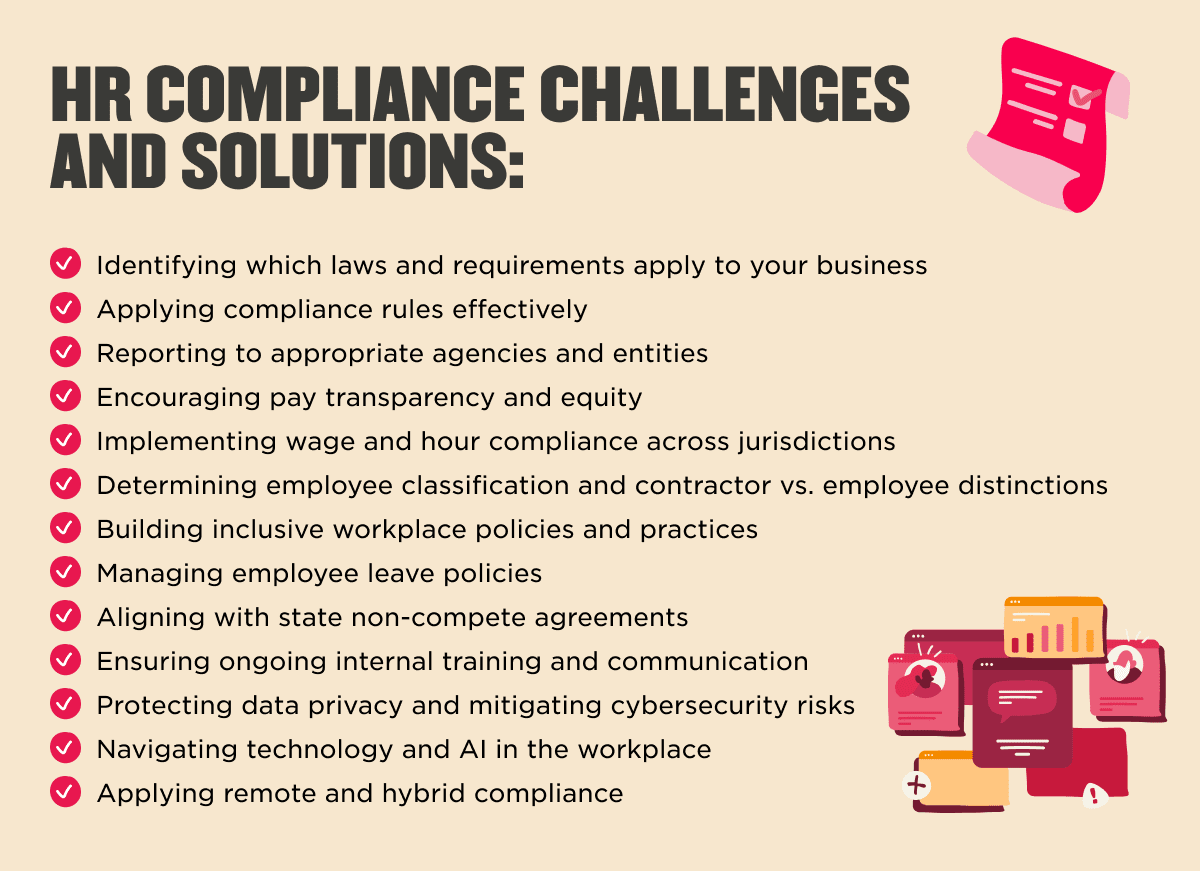HR teams spend an average of 562 hours each year keeping up with employment law changes—yet only 16 percent update their policies more than once a year. That gap creates risk—but it also opens the door for stronger alignment between compliance and culture.
HR compliance means keeping your company’s policies and practices aligned with the applicable laws and regulations that support a fair, safe, and thriving workplace. New labor laws, changing expectations, and evolving best practices make creating guidelines a moving target—but also an opportunity. Each update is a chance to strengthen your foundation, show care for your people, and nurture a culture of transparency.
You don’t have to choose between staying compliant and supporting your team. Let’s explore today’s top HR compliance challenges—and practical ways to overcome each one.
<< Stay up to date with a free HR compliance checklist. >>
The importance of HR compliance
As businesses grow and expand across new locations, HR compliance becomes more than a legal obligation—it becomes a strategic advantage.
A clear compliance framework helps organisations scale with confidence. When processes are aligned with local laws and international standards, HR teams can support new markets, onboard faster, and adapt policies without starting from scratch. That agility makes a real difference in fast-moving industries or global hiring environments.
Strong compliance also supports better decision-making. It creates visibility into how your policies impact people across different roles and regions—revealing gaps, reducing risk, and guiding continuous improvement. Rather than reacting to legal changes or audit requests, you can take a proactive stance, building processes that flex with your culture and workforce needs.
In short, HR compliance sets the stage for sustainable growth. It ensures the basics are covered so you can focus on what matters most: supporting your people and building a workplace they want to be part of.

HR compliance challenges and solutions
With the right tools and mindset, companies can turn the following HR compliance challenges into opportunities for strategic, people-first growth. Here are the most common challenges and solutions to help you stay ahead.
1. Identify which laws and requirements apply to your business
Different industries and regions have their own mix of labor, tax, and safety regulations, and these rules can shift quickly. A 50-person tech startup operates from a different playbook than a 500-person manufacturing company—add multi-national compliance to the mix, and things can get complicated fast.
Suggested action: Start by listing every state or country where your team members work, along with your total headcount in each (many United States regulations, for example, kick in at 15 people or more). Some regions offer support, such as the U.S. Department of Labor’s compliance assistance program, which helps businesses identify and document federal and state obligations. From there, check whether your specific industry has additional standards to meet, like wage laws for hospitality or safety standards for manufacturing.
To stay on top of changes that impact your business, consider using a compliance management platform to track regulatory updates and receive alerts as new laws take effect.
2. Apply compliance rules effectively
When compliance policies exist but aren’t communicated and applied consistently across teams, it can make everyday processes feel disjointed. Different interpretations can lead to confusion, mixed messages, and a lack of clarity about what’s expected, especially as companies grow and teams become more distributed.
Suggested action: Give every team the same playbook to follow by developing standardized compliance workflows. Create clear documentation that spells out how to implement policies, when exceptions apply, and who has final say on tricky cases.
In practice, that might mean building automated workflows in your HR software for things like onboarding, time tracking, or leave approvals. For example, when a new team member completes tax and eligibility forms online, their manager signs off, and HR gets an automatic alert to review and file the documentation. If an exception pops up—such as an extended leave or overtime request—it routes straight to HR or legal for approval. Everyone follows the same steps, nothing slips through the cracks, and compliance runs smoothly.
3. Report to appropriate agencies and entities
Every regulatory body follows its own timelines, forms, and data requirements, from quarterly tax filings to annual Equal Employment Opportunity (EEO-1) and Occupational Safety and Health Administration (OSHA) reports in the U.S. It’s a lot to manage, especially when data sits across different systems or teams are working with limited time and resources.
Suggested action: Build a shared compliance tracker that lists every required report, its due date, and who’s responsible for submitting it. Link each report to its data source—like payroll exports for tax filings or demographic spreadsheets for EEO-1 reports—so information is easy to find come crunch time.
Set automated reminders one month, one week, and one day before each deadline to keep everyone on schedule. Once the reports are in, drop the files and confirmation receipts into a shared, access-controlled folder for audit readiness.

4. Encouraging pay transparency and equity
Pay transparency has become a cornerstone of modern compliance and a major driver of trust. Many US states now require salary ranges in job descriptions, while people expect more clarity around how companies make pay decisions. Both encourage pay equity and strengthen diversity, equity, inclusion, and belonging (DEI&B) initiatives by making it easier to spot and fix pay inequality in the workplace, such as hidden wage gaps across roles and demographics.
Suggested action: Create transparent compensation strategies with clearly defined job levels, pay bands, and progression criteria. Document the factors that influence compensation decisions to show they’re based on legitimate, job-related criteria—like skills, experience, and results—not on protected characteristics. Using an HR analytics platform can help you flag unexplained pay gaps that might indicate unconscious bias or discrimination, so you can develop remediation plans.
Multinational companies can streamline the process by applying consistent policies across regions. “Figure out which jurisdiction has the strictest law and consider whether it’s reasonable to apply that to your practices generally,” says Jamila S. Mensah, Board-Certified Employment and Labor Partner at Norton Rose Fulbright in Houston, Texas. “If you’re complying with the strictest of them, that should check the boxes everywhere.”
5. Implementing wage and hour compliance across jurisdictions
Wage and hour compliance continues to evolve as remote and hybrid work open doors to talent across multiple states and countries. Each region has its own rules for minimum wage, overtime, and breaks, creating new layers of complexity to navigate.
Suggested action: Develop clear, location-specific wage and hour policies that reflect the legal requirements related to your business. Identify where each team member works and what labor standards apply in those regions. When rules overlap (for example, state and local laws set different overtime thresholds), default to the policy that offers the greatest protection to your people.
To stay compliant across locations, HR teams can centralize hybrid work monitoring—like wage and time tracking—in one HRIS system that updates automatically as local laws change.

6. Determining employee classification and contractor vs. employee distinctions
The rise of gig and flex work arrangements has blurred traditional boundaries around how companies classify their people, since worker status determinations vary between agencies and jurisdictions. What qualifies as an independent contractor for tax purposes might not meet labor standards for wage and hour compliance. Misclassifications, however unintentional, increase the risk of penalties, back pay claims, and legal action.
Suggested action: HR teams can stay ahead of misclassification risks by customizing a standard HR compliance checklist to their local laws to evaluate each role before new joiners sign their contract. Look at factors like who controls the work, where they are located, how you structure payment, and whether the role is ongoing or project-based.
For current team members, schedule annual classification audits to confirm that roles and statuses still align with current applicable laws and how the work has evolved.
<< Download a free HR compliance checklist to help navigate changing regulations. >>
7. Building inclusive workplace policies and practices
Inclusive workplaces don’t happen by accident. They’re built through clear, compliant policies that promote fairness and respect. As California-based employment lawyer Jamie E. Wright explains, “[people] are entitled to receive pay and work in an environment free from discrimination and harassment while also having the right to necessary accommodations when required.”
This principle holds true across borders. With anti-discrimination and accessibility laws differing by region, it helps to define clear, measurable inclusion standards that keep policies consistent everywhere your teams work.
Suggested action: Conduct policy audits with inclusion in mind to spot language, processes, or requirements that could unintentionally create barriers for certain groups. Update your policies so they’re aligned with the DE&I policies that apply to you.
For future policies, you can consider inclusive language guidelines that align with laws like the Equal Pay Act and the Americans with Disabilities Act (ADA).
8. Managing employee leave policies
Leave management is evolving fast as jurisdictions implement new paid leave of absence programs, expand family leave eligibility, and create additional protected leave categories. Federal and state laws, such as the Family and Medical Leave Act (FMLA), New York State Paid Family Leave (PFL), and local sick leave regulations create overlapping requirements that challenge even experienced HR professionals.
Suggested action: Start by determining where your people are based—this can help you identify which federal, state, and other local laws apply to each team member. With this visibility, you can manage overlapping leave requirements by building a centralized leave tracker in your HR system. This ensures accruals, balance resets, and eligibility are automatically calculated based on the relevant regulations in each location.
A centralized system reduces the risk of conflict between policies and prevents manual errors, especially when laws intersect. Create clear, consistent workflows for requesting, approving, and documenting leave and accommodations to keep processes compliant and transparent. Stay ahead of changes by subscribing to alerts from local regulatory bodies like the US Department of Labor and updates from programs such as the ADA National Network.

9. Aligning with state non-compete agreements
Non-compete agreements are under intense scrutiny, with states like California and Minnesota banning them outright and others restricting their duration or scope. Existing non-competes might become unenforceable as laws change, while new hires might be subject to different restrictions based on their location or role level. Meanwhile, operating across multiple jurisdictions means juggling consistent people protections with a sliding scale of local compliance requirements.
Suggested action: Start by auditing all existing agreements to identify any non-compete clauses that could conflict with current rules in any jurisdictions where your people work. Consult legal counsel to update or remove language that no longer applies, and track which states ban or restrict non-competes entirely.
Create a shared database of approved contract templates by jurisdiction so hiring managers always use compliant versions. For new hires, replace broad non-compete terms with targeted non-solicitation or confidentiality clauses that protect company interests without limiting team member mobility. Review these agreements annually—or sooner if new legislation passes—to keep your policies consistent, fair, and legally sound across every location.
10. Ensuring ongoing internal training and communication
Compliance only works when everyone understands their role in it. The challenge is that real-life compliance applications often look different across teams. What’s relevant for HR might not match what finance, operations, or frontline managers need to focus on. Each department interprets policies through its own lens, which can make consistency tricky as regulations evolve.
Suggested action: Develop role-based compliance training programs that focus on situations specific to each team rather than broad legal overviews. Use clear, practical language that explains what changed and what actions people need to take. A centralized learning management system (LMS) can log attendance, track completion rates, and send automated reminders before deadlines, making it easy for department heads to spot training gaps early.
Share quick updates and refreshers in team channels or company town halls to keep everyone in the loop and to encourage a culture where compliance feels collaborative, not corrective.
11. Protecting data privacy and mitigating cybersecurity risks
Team member data includes a wide range of information, from personal and payroll details to health records and performance metrics. Each of these data types falls under strict privacy laws, such as the General Data Protection Regulation (GDPR), California Consumer Privacy Act (CCPA), and Health Insurance Portability and Accountability Act (HIPAA). Data security and compliance becomes increasingly important as companies adopt cloud-based HR systems and remote work arrangements.
Suggested action: Map where sensitive information lives—from HR platforms to payroll tools—and document the types of data in each system. Once you know what you’re protecting, you can try strengthening your defenses by encrypting files, turning on multi-factor authentication, and requiring password resets every 90 days.
You might follow up these initial actions with quarterly security reviews that verify access permissions and ensure compliance with GDPR, CCPA, and HIPAA. Keep privacy top of mind through twice-yearly security training sessions, and collaborate with IT on annual penetration tests and monthly phishing simulations.
12. Navigating technology and AI in the workplace
AI software plays a growing role in HR, from screening applicants to analyzing engagement and supporting performance reviews. As its use expands, so do the compliance risks. Unmonitored tools can unintentionally discriminate or mishandle personal data, creating challenges around fairness and privacy. Several jurisdictions, including Illinois, Colorado, and New York City, have introduced laws that require audits or disclosure whenever AI influences hiring decisions.
Suggested action: Create an inventory of every AI tool used in hiring, performance management, or engagement analytics, noting what each one does, the data it relies on, and how its insights shape decisions. Before rolling out new tools, request a bias audit or transparency report from the vendor and review it with your legal or DE&I teams.
Establish clear oversight by pairing every AI-driven process with human review and routinely auditing outcomes across demographic groups. As part of navigating AI adoption, prioritize keeping your people in the loop about when and how you use AI in your HR practices.

Recommended For Further Reading
13. Applying remote and hybrid compliance
Remote and hybrid work have opened exciting new possibilities for flexibility and talent access, but they’ve also added new layers of compliance complexity. HR teams now need to track where people are working, ensure proper tax withholdings, and align benefits policies with local laws. Health and safety requirements can also differ, even for home offices.
Suggested action: Draft clear remote and hybrid work agreements that spell out compliance details unique to distributed teams. Cover essentials like equipment safety, data security, reporting work locations, and expense reimbursement—all aligned with local laws. Pair these policies with time-tracking tools for recording working hours that adapt to time zones and flexible schedules, making it easy for your people to log their hours accurately and managers to support fair workloads.
Simplify compliance with a modern HR platform
With a thoughtful mix of clear policies, consistent training, and supportive technology, compliance can be a natural part of how your business runs instead of feeling like a challenge. Teri Zipper, CEO of HR Executive, put it best: “Compliance is table stakes for HR.” It’s what keeps your business steady so both your people and culture can thrive.
As your company grows and regulations evolve, keeping compliance simple and scalable becomes even more important. Taking a proactive approach now sets your team up for fewer surprises down the road—and ensures you’re supporting your people in a way that’s sustainable.


